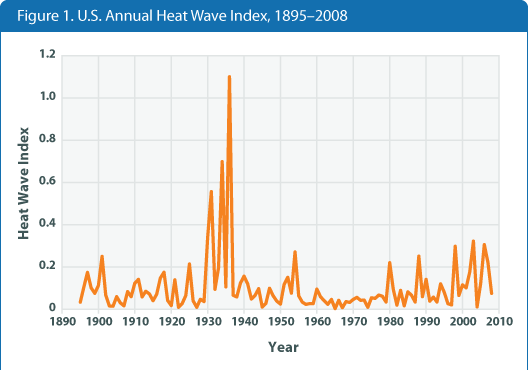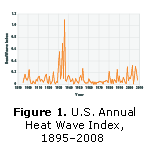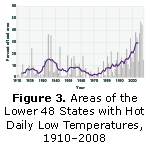Climate Change
Climate Change Indicators in the United States

This figure shows the annual values of the U.S. Heat Wave Index from 1895 to 2008. These data cover the lower 48 states.
Data source: CCSP, 2009 3

This chart shows the percentage of the land area of the lower 48 states with summer daily high temperatures well above normal. The bars represent individual years, while the line is a smoothed nine-year moving average.
Data source: CCSP, 2009 4

This chart shows the percentage of the land area of the lower 48 states with summer daily low temperatures well above normal. The bars represent individual years, while the line is a smoothed nine-year moving average.
Data source: CCSP, 2009 5
Key Points
- Heat waves occurred with high frequency in the 1930s, and these remain the most severe heat waves in the U.S. historical record (see Figure 1). Many years of intense drought (the "Dust Bowl") contributed to these heat waves by depleting soil moisture and reducing the moderating effects of evaporation. 2
- There is no clear trend over the entire period tracked by the index. Although it is hard to see in Figure 1 (because of the extreme events of the 1930s), heat wave frequency decreased in the 1960s and 1970s but has risen since then (see Figure 1).
- Like the heat wave index, the percentage of the United States affected by heat waves has also risen steadily since the 1970s (see Figures 2 and 3). The recent period of increasing heat is distinguished by a rise in extremely high nighttime temperatures.
Background
A heat wave is a prolonged period of abnormally hot weather. With an overall warming of the Earth's climate, heat waves are expected to become more frequent, longer, and more intense in places where they already occur. 1 Increased frequency and severity of heat waves can lead to more illness and death, particularly among older adults, the young, and other vulnerable groups. Excessive heat also can kill or injure crops and livestock, and can lead to power outages as heavy demands for air conditioning strain the power grid.
About the Indicator
While there is no universal definition of a heat wave, this indicator defines a heat wave as a four-day period with an average temperature that would only be expected to occur once every 10 years, based on the historical record.
This indicator reviews trends in the U.S. Annual Heat Wave Index between 1895 and 2008. This index tracks the frequency of heat waves across the lower 48 states, but not the intensity of these episodes. The index uses daily maximum temperature data from the National Oceanic and Atmospheric Administration, which keeps records from weather stations throughout the nation. Approximately 300 to 400 stations reported data from 1895 to 1910; over the last 100 years, the number of stations has risen to 700 or more.
The index value for a given year could mean several different things. For example, an index value of 0.2 in any given year could mean that 20 percent of the recording stations experienced one heat wave; 10 percent of stations experienced two heat waves; or some other combination of stations and episodes resulted in this value.
For additional perspective, this indicator also looks at heat waves in terms of size (percent of area affected) and the difference between trends in daytime high temperatures and trends in nighttime low temperatures.
Indicator Confidence
Temperature data are less certain for the early part of the record because fewer stations were operating at that time. In addition, measurement instruments and procedures have changed over time, and some stations have moved. The data have been adjusted to account for some biases, however, and these uncertainties are not sufficient to change the fundamental trends shown in the figures.
This indicator does not consider humidity, which can have additional health impacts when combined with heat.
Data Sources
The data for this indicator are based on measurements from the National Oceanic and Atmospheric Administration's National Weather Service Cooperative Observer Network. These weather station data are available online at: www.nws.noaa.gov/os/coop/what-is-coop.html.
Indicator Documentation
- Download related technical information PDF (4 pp, 34K)





